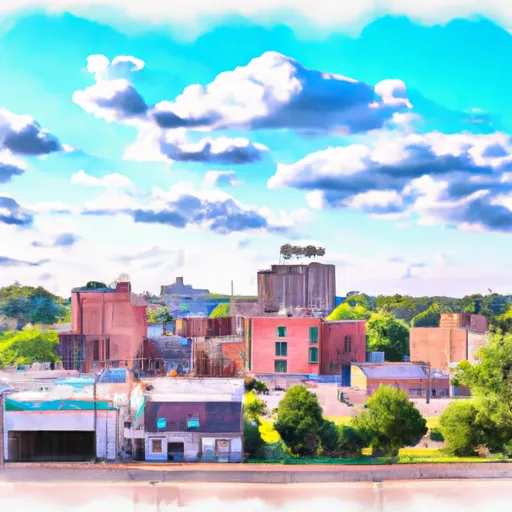-
 Snoflo Premium
Snoflo Premium
Get unlimited access to all our content
With no Ad interruptions! - Start Your Free Trial Login with existing account
Pontiac
Eden Index
Climate
8.0
•
Recreation
2.5
•
Community
2.8
•
Safeguard
4.8/10

Pontiac is a charming city located in Livingston County, Illinois. It has a diverse climate with warm summers and cold winters. The average temperature in the summer ranges from 70°F to 90°F, while in the winter, it can drop to around 20°F. Precipitation is fairly evenly distributed throughout the year, with an average of 35 inches annually, including both rain and snow.
The city of Pontiac is not situated near any major bodies of water, but it is crossed by the Vermilion River and contains several smaller creeks and streams. These waterways provide opportunities for fishing, kayaking, and canoeing, allowing outdoor enthusiasts to enjoy the natural beauty of the area.
Pontiac is known for its outdoor recreation opportunities. The city has numerous parks and green spaces, including the scenic Humiston-Riverside Park, offering walking trails, picnic areas, and playgrounds. Golf enthusiasts can enjoy the beautiful Pontiac Elks Golf Course, which offers an 18-hole course with challenging fairways and well-maintained greens.
In conclusion, Pontiac, Illinois has a moderate climate, diverse hydrology constituents, and a range of outdoor recreational activities, making it an appealing destination for nature lovers and outdoor enthusiasts.
What is the Eden Index?
The Snoflo Eden Index serves as a comprehensive rating system for regions, evaluating their desirability through a holistic assessment of climate health, outdoor recreation opportunities, and natural disaster risk, acknowledging the profound impact of these factors on livability and well-being.
Climate Health Indicator (CHI): 8.0
Pontiac receives approximately
916mm of rain per year,
with humidity levels near 82%
and air temperatures averaging around
11°C.
Pontiac has a plant hardyness factor of
5, meaning
plants and agriculture in this region thrive during a short period during spring and early summer. Most
plants will die off during the colder winter months.
By considering the ideal temperature range, reliable water supplies, clean air, and stable seasonal rain or snowpacks, the Climate Health Indicator (CHI) underscores the significance of a healthy climate as the foundation for quality living.
A healthy climate is paramount for ensuring a high quality of life and livability in a region, fostering both physical well-being and environmental harmony. This can be characterized by ideal temperatures, reliable access to water supplies, clean air, and consistent seasonal rain or snowpacks.
Weather Forecast
Streamflow Conditions
Lower Illinois
Area Rivers
Lower Illinois
Snowpack Depths
Lower Illinois
Reservoir Storage Capacity
Lower Illinois
Groundwater Levels
Recreational Opportunity Index (ROI): 2.5
The Recreational Opportunity Index (ROI) recognizes the value of outdoor recreational options, such as parks, hiking trails, camping sites, and fishing spots, while acknowledging that climate plays a pivotal role in ensuring the comfort and consistency of these experiences.
Access to outdoor recreational opportunities, encompassing activities such as parks, hiking, camping, and fishing, is crucial for overall well-being, and the climate plays a pivotal role in enabling and enhancing these experiences, ensuring that individuals can engage in nature-based activities comfortably and consistently.
Camping Areas
| Campground | Campsites | Reservations | Toilets | Showers | Elevation |
|---|---|---|---|---|---|
| Coon Creek - Shelbyville Lake | 230 | 666 ft | |||
| Opossum Creek - Shelbyville Lake | 80 | 654 ft | |||
| Lake Tom Bailey | 32 | 299 ft | |||
| Stephen A. Forbes State Park | 135 | 604 ft | |||
| Clarkco State Park | None | 273 ft | |||
| Charley Brown City Park | None | 487 ft | |||
| Twiltley Branch - Okatibbee Lake | None | 421 ft | |||
| Dunns Falls Water Park | None | 269 ft | |||
| Archusa Creek Waterpark | 69 | 315 ft | |||
| Sam Dale Lake Conservation Area | None | 493 ft |
Nearby Ski Areas
Catastrophe Safeguard Index (CSI):
The Catastrophe Safeguard Index (CSI) recognizes that natural disaster risk, encompassing floods, fires, hurricanes, and tornadoes, can drastically affect safety and the overall appeal of an area.
The level of natural disaster risk in a region significantly affects safety and the overall livability, with climate change amplifying these risks by potentially increasing the frequency and intensity of events like floods, fires, hurricanes, and tornadoes, thereby posing substantial challenges to community resilience and well-being.
Community Resilience Indicator (CRI): 2.8
The Community Resilience Indicator (CRI) recognizes that education, healthcare, and socioeconomics are crucial to the well-being of a region. The CRI acknowledges the profound impact of these elements on residents' overall quality of life. By evaluating educational resources, healthcare accessibility, and economic inclusivity, the index captures the essential aspects that contribute to a thriving community, fostering resident satisfaction, equity, and social cohesion.

